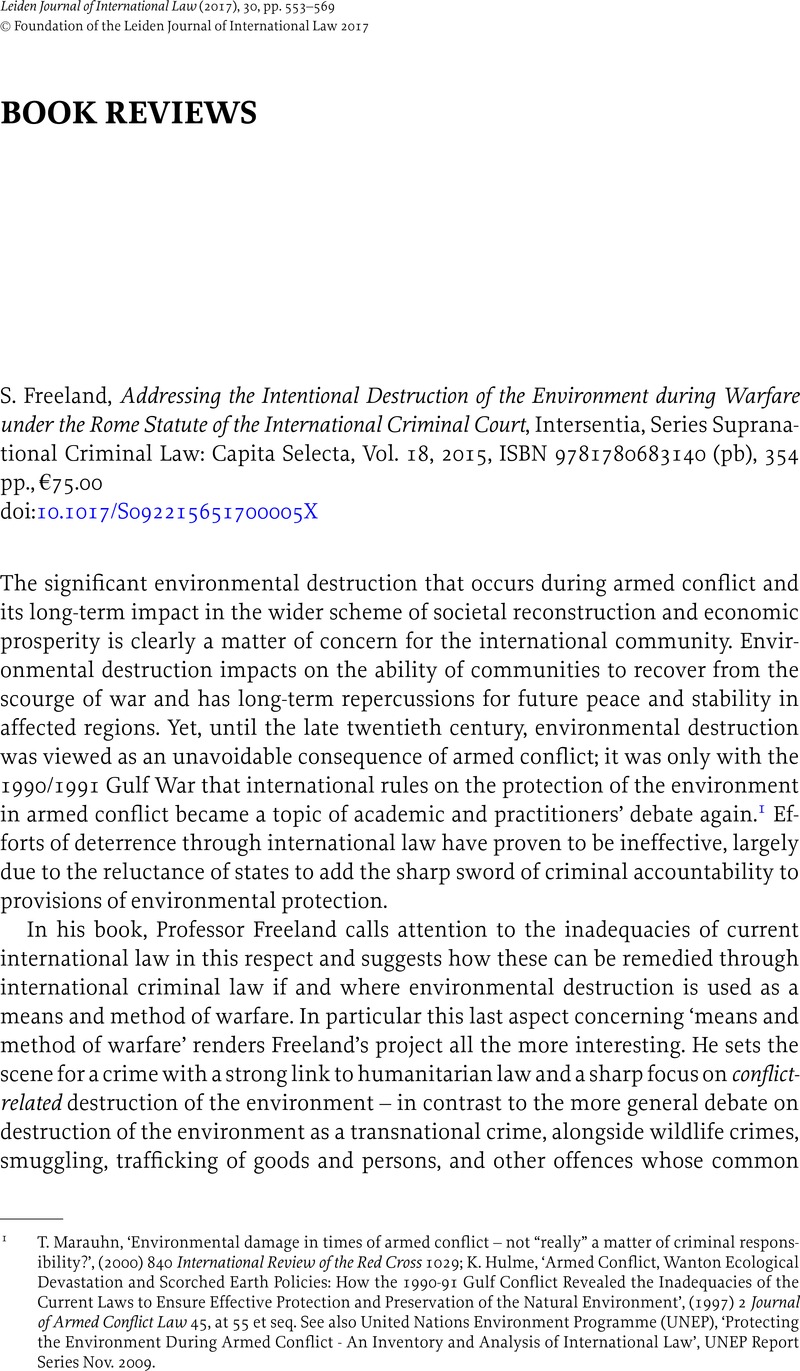No CrossRef data available.
Article contents
S. Freeland , Addressing the Intentional Destruction of the Environment during Warfare under the Rome Statute of the International Criminal Court, Intersentia, Series Supranational Criminal Law: Capita Selecta, Vol. 18, 2015, ISBN 9781780683140 (pb), 354 pp., €75.00
Published online by Cambridge University Press: 06 March 2017
Abstract

- Type
- BOOK REVIEWS
- Information
- Copyright
- Copyright © Foundation of the Leiden Journal of International Law 2017
References
1 Marauhn, T., ‘Environmental damage in times of armed conflict – not “really” a matter of criminal responsibility?’, (2000) 840 International Review of the Red Cross 1029 CrossRefGoogle Scholar; Hulme, K., ‘Armed Conflict, Wanton Ecological Devastation and Scorched Earth Policies: How the 1990-91 Gulf Conflict Revealed the Inadequacies of the Current Laws to Ensure Effective Protection and Preservation of the Natural Environment’, (1997) 2 Journal of Armed Conflict Law 45, at 55 et seqCrossRefGoogle Scholar. See also United Nations Environment Programme (UNEP), ‘Protecting the Environment During Armed Conflict - An Inventory and Analysis of International Law’, UNEP Report Series Nov. 2009.
2 S. Freeland, Addressing the Intentional Destruction of the Environment during Warfare under the Rome Statute of the International Criminal Court (2015), 41.
3 Freeland, supra note 2, at 45.
4 Freeland, supra note 2, at 49–101. Freeland also hints at the underlying fundamental problem that in international humanitarian law, salient principles such as military necessity and rigid standards (see Arts. 35(3), 55(1) of the 1977 Protocol Additional to the Geneva Conventions of 12 August 1949, and relating to the Protection of Victims of International Armed Conflicts (Protocol I), 1125 UNTS 3) lead to a very limited coverage of environmental crimes; Freeland, supra note 2, at 85 et seq., and 116.
5 Freeland, supra note 2, Section 3.2. In conclusion, Freeman posits that, ‘it is not entirely clear as to whether, and if so, how, some of [the jus in bello] rules apply to the environment at all’. This stands to an extent in contrast with ICRC – Henckaerts, J.-M. and Doswald-Beck, L. (eds.), Customary International Humanitarian Law, Volume I: Rules (2005), Chapter 14, Rules 43–5CrossRefGoogle Scholar.
6 Freeland holds quite accurately that, ‘the rules that purport to protect the environment are characterized by vagueness and uncertainty’ and are, thus, anything but comprehensive, Freeland, supra note 2, Section 3.5, at 175–6.
8 See 1998 Rome Statute of the International Criminal Court, 2187 UNTS 90 / 37 ILM 1002, Preamble, para. 3.
9 Freeland accurately notes that neither the crime of genocide nor crimes against humanity contain elements specifically targeting the environment; this is a feature limited to the war crimes provision. See Freeland, supra note 2, Sections 4.4.1 and 4.4.2, particularly at 204.
10 Freeland is right in holding that caution is warranted in taking guidance directly from the Convention on the Prohibition of Military or Any Other Hostile Use of Environmental Modification Techniques (ENMOD Convention) in the context of Art. 8(2)(b)(iv) of the Rome Statute, Freeland, supra note 2, Section 4.4, at 208–9. See also G. Werle and F. Jeβberger, Principles of International Criminal Law (2014), para. 493.
11 Freeland, supra note 2, Section 5.3.2, at 245.
12 Freeland's approach to embed the new crime in international humanitarian law language (also regarding the term ‘method or means of warfare’) is – again – sensible; the prohibition of acts of destruction of the environment finds its sources in international humanitarian law and a complete detachment of the crime from the armed conflict context would risk to leave the grounds of what even in the most progressive view can be considered an international crime materializing in customary law.
13 Freeland, supra note 2, Section 5.1.2.2, at 229; see also, as part of a more comprehensive chapter on the international quality of the crime, Section 5.2, at 235.
14 In Freeland's definition, a person has intent where ‘. . . (iii) that person consciously disregards information that clearly indicates a substantial likelihood that such damage will occur in the ordinary course of events’, see Freeland, supra note 2, Section 5.3.2.1, at 245.
15 Freeland, supra note 2, Section 5.3.2.1, at 250 et seq.


